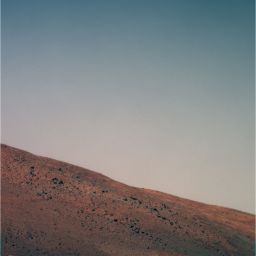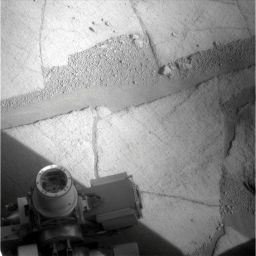A.J.S. Rayl • Jan 31, 2008
The Mars Exploration Rovers Update: Spirit and Opportunity Begin Fifth Year of Exploration in Shadow of "Little Sasquatch "
The Mars Exploration Rovers celebrated their fourth birthdays and began their fifth year of exploring this month -- and for the first time since the big dust storm hit the headlines last summer, Spirit and Opportunity made the news. It wasn't for the notable exploration or engineering milestone they had just achieved or the discoveries they've helped scientists make about a once very different Mars. It was because of an alleged "Bigfoot" sighting.
"Bigfoot was actually two inches tall and didn't move at all while we took all four images," chuckled Steve Squyres, the lead scientist for the rover's science payloads, between flight operations yesterday. "What can you say? It must have been a slow news week."
Spirit took the picture in which the alleged Martian "Teeny Little Bigfoot" appears last November from its position on top of Home Plate, the eroded over volcano it has been working on and around for more than a year. The picture is among the hundreds of images that went into the making of the West Valley panorama. Now, for better or worse and all the wrong reasons, that panorama is one of the most looked-at and downloaded from the entire MER mission. "The JPL photo servers were just about brought to their knees by everybody trying to download this image," reported Bruce Banerdt, MER project scientist, of the Jet Propulsion Laboratory, where the rovers were built and are being managed.
Reality checked, if you haven't already gotten the scoop, "Teeny Little Bigfoot" is a little Martian rock. Yes, a rock in a panorama taken by Spirit that, shadowed as it was, resembled in an eBay kind of way the Patterson Bigfoot making its way through the foothills of the Columbia Hills. The image -- but a tiny portion of the panorama blown up -- hit the Internet, then last week was picked up by major television news channels and "Teeny Little Bigfoot" took on a life bigger than the rovers to the dismay of many people who have been following the MER mission. [See Emily Lakdawalla's detailed report in The Planetary Society Weblog]
The Martian stone also took on a number of non de plumes, including "Little Man," and "Little Mr. Sasquatch," and "The Martian Sasquatch." Perhaps more than anything the media traction the little stone got is a sad reflection of how desperate Americans are to find a little levity in life or an indicator of how easily gullible or amused most people are.
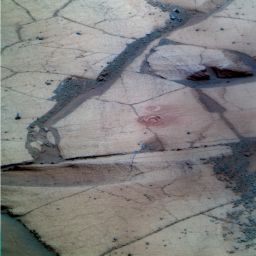 Digging Lyell
Digging LyellOpportunity took this image with its Pancam on Sol 1400 (Jan. 2, 2008) of the hole it dug with its rock abrasion tool into part of the Lyell layer inside Victoria Crater. Lyell is the third of a tri-layer band of rock that circles the inside of Victoria Crater that the rover has been studying for the last several months.
Credit: NASA / JPL-Caltech / Cornell
Meanwhile up on Mars, as fall fell in the southern hemisphere of the planet and "Teeny Little Bigfoot" made the news, Spirit and Opportunity did indeed achieve another significant milestone as they roved past their 4th birthdays and into their fifth year of exploration.
Spirit arrived at its third winter haven at Home Plate North before the Christmas holidays last year and backed just down over the edge to tilt its solar arrays at 13 degrees toward the Sun. This month, the rover repositioned itself three times on that edge, inching backward and further down the slope, getting in what science it can.
"We've been doing gradual little bumps down the hill to increase our tilt angle, following the Sun as it heads north and taking images of the stuff around us and doing some IDD [instrument deployment device] work," Squyres said. The rover completed the Tuskeegee Panorama this month, named in honor of the Tuskegee Airmen of World War II fame, and also completed an in-depth investigation of a rock called Chanute.
On the other side of the planet Opportunity continued its investigation of the tri-layered rock ring that circles the interior of Victoria Crater. The rover is still in the Lyell region, now about 15 meters below the rim, working on its fourth target in that third layer of the rock band. "We're on steep slopes, but the drives have been fine," said Jake Matijevic, chief of the MER engineering team.
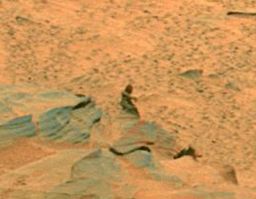 "Little Mr. Sasquatch"
"Little Mr. Sasquatch"The rest of the story: "Little Bigfoot" aka "Little Mr. Sasquatch," left Mars. The latest sighting was at Cornell University of all places. "Little Mr. Sasquatch made an appearance in Astronomy 102," astronomy professor Steve Squyres confirmed. "I used him as an example of how weird science stories can pop up in the media and be utter nonsense and the media cascade that follows when one outlet picks a story up and next thing you know it's on CNN. We're trying in the course to equip people with a basic appreciation for science and the ability as they go forward in life to skeptically and critically judge and think about things they hear about science," he clarified. After class, "Little Bigfoot" aka "Little Mr. Sasquatch," was reported to have quickly skulked off campus, mumbling something about a Burger King in Kalamazoo, then disappeared into the woods around Ithaca. No sightings of the little guy have been reported since, either in New York or on Mars.
Credit: NASA / JPL-Caltech / Cornell
The weather appears typical for fall at both Gusev Crater and Meridiani Planum, at least as far as we can know. The MER team continues to get periodic reports from the Mars Color Imager (MARCI) instrument on Mars Reconnaissance Orbiter (MRO), which is taking long broad view images of the planet. "The weather is following a fairly predictable pattern, very much like that which we've seen on two previous falls, that is, the skies are slowly clearing and we can measure that with our daily tau measurements," Matijevic said in an interview yesterday. "It's very consistent with the fall-to-winter conditions and there's been no real change in the last month."
The hoped-for gust of wind at Gusev to help clear some of the layers of dust from Spirit's blotted solar arrays was not forthcoming over the holidays and no one seriously expects any such event now. "At this time of the year, we just don't see those kinds of winter storm conditions that would manifest themselves as wind events, at least if our experiences for the last two Mars years are representative," added Banerdt.
As a result and as expected, energy levels are dropping on both rovers. Even though Spirit is in its winter haven and now has its solar arrays tilted at 22 degrees, it's only averaging about 260 watt-hours of power and is now on its winter schedule of working about 1.5 hours a day. "Even with the tilt, energy has been somewhat limited," Matijevic said. "We've been no higher than 280-watt hours in this whole month period and we're currently at 260 watt-hours." That noted, these are the numbers they anticipated. "It's falling more or less within what we predicted, maybe a little better," he confirmed.
Power levels have been decreasing on Opportunity as well. "We were generating 700 watt-hours but over last month and half and we're down to about 500 watt-hours," said Matijevic. "That's still plenty good for the kinds of activities we're doing." Banerdt agreed: "Power really isn't an issue for Opportunity at all. We're able to do pretty much all the measurements and we're still shunting power. We more data constrained."
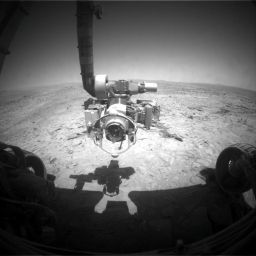 Hanging on Home
Hanging on HomeSpirit took this image with its front hazard camera on Sol 1425 (Jan. 26, 2008)following the third manuever this month of "bumping" or inching backward down the slope at Home Plate North to tilt its solar arrays toward the Sun. Since it is fall turning to winter in the southern hemisphere of Mars, the Sun is rising and staying lower in the sky. Even though the rover has inched a little further down three times this month, Spirit's front wheels are still actually on top of Home.Credit: NASA / JPL-Caltech / Cornell
The reason the rovers are "data constrained" is because they don't have a hard drive to store and backlog a lot of the data they collect, so must continue to downlink data from their flash memory or risk having their "brains" go awry.
At the same time, there is only so much time they can get and Odyssey, their primary link, can schedule with the Deep Space Network (DSN), which channels all the data coming from NASA's missions.
Since Spirit and Opportunity landed in January 2004, Cassini has arrived at Saturn, MRO at Mars, Messenger at Mercury, Phoenix is on its way to Mars, and the list goes on. The DSN is booked solid.
The bottom line remains as it has for years now: the MER mission has gone on far longer than anyone ever dreamed it would. "There are people on this mission who have spent more than 10% of their lives operating these rovers," Squyres pointed out. "If you're under 40 years old and were with the team from Day One when we landed, you have spent more than 10% of your life on this mission. We've been doing this for a very long time."
It's been four Earth years -- that's high school or college (undergrad) -- it is a chunk of one's life to be sure and a lot has happened during the first four Earth years on this first robotic overland expedition of Mars. Spirit and Opportunity have each established enough rover records to fill a book almost and together they set a standard that makes them the giant robot rovers on whose masts new robot rovers will stand. Certainly that would seem worthy of mention along with "Teeny Little Bigfoot."
"You look back and the stand-out things you remember are the thrilling discoveries, like the original discoveries of bedrock and evidence of water at Meridiani and the silica, for example, at Gusev," Squyres reflected. "And then the really heartwarming parts, the tough parts we managed to fight our way through, losing the wheel with Spirit and the two rough winters with Spirit, Purgatory Dune, and the dust storm."
Spirit and Opportunity have pulled through so many times that it's hard to believe sometimes that these rovers will someday stop roving. Still, the axiom lives large and breathes in space: anything can happen anytime. "For vehicles that were designed to last three months and are now four years old you can't consider anything to be bulletproof," as Squyres put it. The crewmembers are constantly cognizant and ever vigilant about what their rovers are up against in the hostile environments they're roving.
 Lyell Panorama
Lyell PanoramaDuring four months prior to the fourth anniversary of its landing on Mars, Opportunity examined rocks inside an alcove called Duck Bay in the western portion of Victoria Crater. The main body of the crater appears in the upper right of this panorama, with the far side of the crater lying about 800 meters (half a mile) away. Bracketing that part of the view are two promontories on the crater's rim at either side of Duck Bay. They are Cape Verde, about 6 meters (20 feet) tall, on the left, and Cabo Frio, about 15 meters (50 feet) tall, on the right. The rest of the image, other than sky and portions of the rover, is ground within Duck Bay. The targets of study during the last several months are the rock layers within a band exposed around the interior of the crater. Bright rocks within the band are visible in the foreground. The rover science team named the three subdivisions of the band Steno, Smith, and Lyell, after legendary geologists. This view combines many images Opportunity took with its Pancam from Sols 1332 through 1379(Oct. 23 to Dec. 11, 2007). Images taken through Pancam filters centered on wavelengths of 753 nanometers, 535 nanometers and 432 nanometers were mixed to produce this view, which is presented in a false-color stretch to bring out subtle color differences in the scene. Some visible patterns in dark and light tones are the result of combining frames that were affected by dust on the front sapphire window of the rover's camera.Credit: NASA / JPL-Caltech / Cornell
The year ahead -- 2008 -- is, in a capsule, all about survival for Spirit and moving on for Opportunity.
"Once springtime comes, we want to send Spirit off in search of new evidence of hydrothermal activity at Gusev," Squyres said. "I want to find more silica. The thing that's going to tell us the silica story is not the silica itself, but where it occurs and what it occurs in conjunction with. We have found a lot of places with silica and they're all different from one another. I'm sure there are more. But we've got to get Spirit through this winter and it's going to be a tough, tough winter," he acknowledged.
Opportunity, meanwhile, will be wrapping up the Victoria campaign and roving onward, but where exactly has not been determined. "The issue is how long do we dare stay inside Victoria Crater? At what point do we decide it's time to get out on the plains and do something new?" said Squyres. "The rover is doing great and is in great health, but if we lose a wheel, it's going to be tough getting out." There is no reason to suspect there is anything wrong with Opportunity's wheels. "But the characteristics of some of these failures is you don't see them coming. We're pushing these rovers awful hard." Opportunity's next major destination awaits a decision the MER team will probably make soon.
While there is little concern about Opportunity this Martian winter, there is every concern about Spirit. Still, optimism continues to be high, even though predictions put this rover's chances of survival right on the edge.
The thing is, these rovers have been on the edge so many times and have pulled through so many time that it's almost hard to imagine them not pulling through for one more sol, one more rove. The day when they rove no more will come, but it's not really in the MER team's forecast at this point. "The feeling among the science team is that the great engineering team at JPL will figure out a way to make it work," said Banerdt. "We're pretty sure we're going to come out the other side with a healthy rover. We still have a long ways to go, but we're all very optimistic."
Spirit From Gusev Crater
As 2007 turned to 2008, Spirit was in its third winter haven, perched over the edge of Home Plate North and in the midst of acquiring the Tuskegee Panorama. The rover began the latest panorama project just before Christmas on Sol 1412 (December 23, 2007) once it backed into its first position on the edge. There, it tilted its solar panels at 13 degrees toward the Sun and the rover spent the last of the holidays through the first week of the New Year, to Sol 1428 (January 8, 2008), taking the hundreds of images for the panorama.
The MER science team decided last month to honor the Tuskegee Airmen, the first black pilots to serve in the U.S. military, by naming features in the area after the men, bases, and places they flew. Two of the renowned pilots visited rover planners in early December 2007 at JPL and shared stories about serving in World War II, as well as learned about rover operations.
"The Tuskegee Panorama is a fascinating panorama because you can see our tracks going back onto Home Plate and where we first drove past it [March 2006] as we were headed over to McCool Hill before our wheel broke, said Banerdt. "The tracks we made then, at the base of the slope we're sitting on right now, are almost completely obliterated since we drove by as a result of Aeolian processes, the ways in which the surface is shaped by the winds." The finished Tuskegee Panorama is still to be released.
One of the newest investigations ongoing in the MER science operations is a comparison of Pancam and Navcam images from March 2006 to characterize how these kinds of features are being erased either by dust deposition or the wind blowing dust on the ground. "It's giving us the opportunity to do some really detailed comparisons of things we disturbed with our rover two winters ago and we can now come back and look at and compare," said Banerdt.
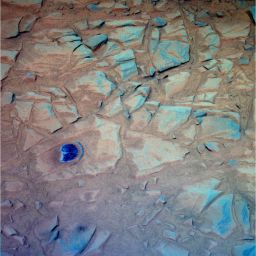 Chanute
ChanuteSpirit took this image of Chanute and the abrading it did with its rock abrasion tool on Sol 1442 (Jan. 24, 2008) with its Pancam. The rover took the image just after it "bumped" for a third time this month, inching a bit further down the slope off the north edge of Home Plate to tilt its solar arrays 22 degrees.Credit: NASA /JPL-Caltech / Cornell
After finishing the Tuskegee Panorama, Spirit inched backward on the edge at Home Plate North once a week for the next three weeks. The rover "bumped" 10 centimeters (about 4 inches) on Sol 1429 (January 11, 2008) increasing the tilt to 15.7 degrees, then again on Sol 1436 (January 18, 2008), for 9 centimeters (3.5 inches) increasing the tilt to 18 degrees. And, on Sol 1440 (January 22, 2008) Spirit "bumped" 13 more centimeters (5.1 inches) further down the edge increasing the tilt to 22 degrees. That's where it is currently positioned. Despite the number of moves it's made, the rover's front two wheels are still actually on top of Home Plate.
After every move -- though these "bumps" have not really moved the rover's position by much -- the science team has chosen a target or two to perform some in situ science with the microscopic imager (MI), the rock abrasion tool (RAT) brush, Mössbauer spectrometer and alpha particle X-ray spectrometer (APXS).
The rover really did an in-depth study of the "most significant" of those targets, by Squyres' reckoning, a rock called Chanute, in the last week or so, following its last "bump."
Chanute is basically the top surface of the Home Plate stack, the stratigraphic top of that stack," elaborated Banerdt. But as good as that top layer looks, the stratigraphy down slope doesn't look so good. "Our original hope as we went down this slope, progressively tilting the solar panels, was to do a fairly detailed survey of the stratigraphy of Home Plate. But from what we've been able to see from the Pancam, it doesn't look like a lot of rocks on this slope have been in place. The very top most layers probably are in place, but there's been a lot of slumping, where the rocks have broken off and rolled down hill a bit. So the bedrock isn't very far down this slope and the rocks exposed to the surface are loose."
Despite the fact that the site doesn't represent as "juicy" of a science target as the team members had hoped, the top layers still hold a lot appeal and they plan to "get a pretty good characterization" of them, said Banerdt.
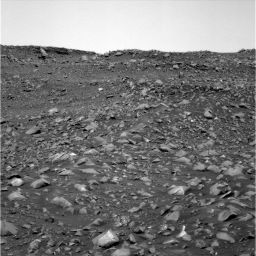 Old woman on Mars
Old woman on MarsSpirit took this image back when it was climbing Husband Hill. Look in the upper left hand corner to see the old stone woman, with a bonnet, walking up the hill. Perhaps we can enlist eHarmony to arrange a date with "Little Mr. Sasquatch." Soon, the MER mission will establish another milestone: most urban legend spinning images from Mars.
Credit: NASA / JPL-Caltech / Cornell
The plan now calls for Spirit to continue IDD work, APXS and Mössbauer spectrometer integrations on the topmost layers, as well as MI imaging of the details of the texture and the layering in the top few tens of centimeters of the bedrock that is in place. "We think there's a lot of good science to be done, especially since most of our time is going to be spent at the very top of the layered stack," offered Banerdt.
Spirit is putting in about 1.5 hours of week a day these days. "That is a good day for being awake at this time," Matijevic assured. Sometimes, however, depending on the science agenda, the rover may work less than an hour during the Martian sol.
"We will skip a little bit and cut that back to an hour or so or less if we're going to do one of the Mössbauer spectrometer or APXS integrations," Matijevic said. The spectrometer integrations or observations take hours now, more than 40 hours to get a good read on the iron content of a target with the Mössbauer, and an overnight integration sucks about an amp hour or more from the battery. "We will run a little bit of deficit overnight with the spectrometer on, so that we can get the hours needed for those spectrometer measurements," the rovers' chief engineer confirmed. Usually, they try to make it up also by dropping a UHF pass.
Although the MER team is still observing the morning communications passes -- using them for command uploads about every other day -- they are in fact now dropping about one of every three UHF passes. "We're not collecting a lot of data at this time, so we generally look ahead at the return performance of the pass and pick one that looks like it will generally be a poorer performer and drop that for energy reasons," Matijevic explained. "That works out to be a gain of a little over an amp hour on the battery and as a result of that we essentially make up for the integrations we're doing over night."
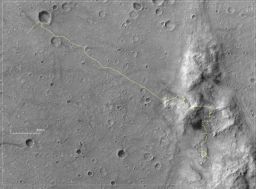 Four years of exploration
Four years of explorationThe yellow line on this map, which is overlaid onto a portion of an image taken by the High Resolution Imaging Science Experiment on MRO on Nov. 22, 2006 shows Spirit's route. on the of Spirit's time on Mars. By its Sol 1386 (Nov. 26, 2007), nearly 47 months into a mission originally planned to last three months, Spirit had driven 7,435 meters (4.62 miles. From its landing site near the northwest corner of this map, Spirit crossed a plain to reach the Columbia Hills, climbed up to the summit of Husband Hill, then descended and roved back into the Inner Basin of the range, near the southeast corner of the map, where it crossed northward on a low plateau called Home Plate. Credit: NASA / JPL-Caltech / UAz/ Cornell / NM Museum of Natural History and Science
In the worst case scenario, if the engineers had to power down Spirit, they could, theoretically, start it back up, though that's not something they plan to do. "It's more likely that we'll try to stay with a pattern of commanding and data return, simply since that's a way for us to kind of verify the system is still alive and active," he pointed out. At the depth of winter, the team anticipates reducing communication to once or twice a week and keeping the rover active just enough to keep the heat energy from the instruments warming the electronics box to keep it from getting too cold.
"The reason we wouldn't try to mothball Spirit or in some fashion put it into a mode where we don't contact it is that, as time goes on, we can expect to see slow changes in clock drifts and things like that that may make it more difficult to communicate with it when we finally get around to doing so," Matijevic expounded.
While there are ways of resetting the so-called mission clock, which would be stopped if Spirit was "shut" down, there are other reasons to keep the little rover online, not the least of which is learning just what these rovers' limits are. "It's important to get measurements when we can, because they help us characterize the state of the energy production on the system is and how the system is responding," he said. "And there are measurements we can take even under low power conditions that are still beneficial from the surface environment monitoring perspective."
In coming weeks, as the Sun heads further north on the Martian horizon and the temperatures drop, the solar-powered rover will inch backward a little more and tilt its arrays to take in as much sunlight as possible. "Once it drops to about 240 watt-hours, we'll bump again," said Squyres.
 West Valley Panorama
West Valley PanoramaThe images for this panorama were taken by the Mars Exploration Rover Spirit from Sols 1366 to 1369 (Nov. 6-9, 2007) from its position on the edge of Home Plate. The view spans about 180° around the rover, from southwest to northeast. A rock-dotted hill in the middle distance across the left third of the image is Tsiolkovski Ridge, about 30 meters or 100 feet from the edge of Home Plate and about that same distance across. A bump on the horizon above the left edge of Tsiolkovski Ridge is Grissom Hill, about 8 kilometers or 5 miles away. At right, the highest point of the horizon is Husband Hill, to the north and about 800 meters or half a mile away. "Little Mr. Sasquatch" was found in the left portion of the image. This version was produced by James Canvin, and can be downloaded at its full resolution from his website.
Credit: NASA / JPL / Cornell / James Canvin
Matijevic predicts that will be in a couple of weeks, confirming that it can still achieve a more rewarding tilt. "This time of year the Sun is about 10 degrees north and because the landing site is 14.9 degrees south, it makes an apparent change in the Sun's position of 24 to 25 degrees," he noted. "So even at 22 degrees, the angle at which Spirit's solar arrays are now tilted, we're tilted so that the Sun is slightly further down on the horizon from where we're located. We could actually tilt more to be aligned with the high point of the Sun in the sky from the view of the southern hemisphere."
For Spirit, the days ahead will be dicey and it will probably spend weeks doing very little science, if any at all. "It's going to be quiet as a church on Wednesday, just like Opportunity was during the dust storm," predicts Banerdt. "But the engineers will be using every trick in the book to keep Spirit alive come next June and winter solstice. I don't think anybody on the science team feels we're going to lose this rover."
OPPORTUNITY FROM MERIDIANI PLANUM
Opportunity celebrated the New Year at Lyell, the third layer in the rock ring or band the circles the interior of Victoria Crater, the top of which is located about 6 meters (20 feet) below the rim. The rover stayed on after the party was over and spent the month of January examining a couple more targets deeper down in the Lyell region.
Although Opportunity has not been wanting for energy the way Spirit has been, the pace of work inside Victoria Crater slowed somewhat with the New Year. "It's been a little slow because we've been dealing with some joint stalls and things like that," said Banerdt. "The instrument deployment device (IDD) doesn't work quite like we're expecting it to, because we're sitting on this 20-degree slope and the sideways loading causes it to pull a little more current than we expect sometimes. When that happens, we have to stop and do diagnostics and make sure we're not doing anything damaging to the arm."
Opportunity is, like Spirit, showing the signs of rover age. Even so, the engineers on the ground at JPL with the engineers of the companies that designed and built the instruments have been ingeniously successful at creating "workarounds" or ways of getting things to work but in a different way. "The RAT is back to working with the new strategy and it seems to be working well," reported Matijevic. "There is still a bit of excess debris because of the bent brush, he said. "But it's working," says Matijevic. And the MER science team members are having Opportunity dig in at Lyell.
 Mars: 2007 opposition
Mars: 2007 oppositionThe Hubble Space Telescope took this photo of Mars during its 2007 opposition, when it was about 90 million kilometers from Earth. This view was captured on Dec. 1, 2007 and is centered at a longitude of about 50 degrees. Credit: NASA, ESA, the Hubble Heritage Team (STScI/AURA), J. Bell (Cornell ), and M. Wolff (Space Science Institute, Boulder)
In recent sols, Opportunity has descended further into Victoria Crater, still on Lyell, which actually is quite an extensive layer. "Opportunity has moved down to the very lowest, deepest portion of the Lyell layer, the lowest in the band of stratigraphy, as deep as it can go and still be at Lyell," Squyres said. Currently, Opportunity is about 15 meters from Victoria's rim and is conducting a fourth RAT grind Lyell, on a target called Buckland.
"We're slowly putting together this whole sequence of measurements as the rover has gone through the stratigraphic column and we're doing the final characterization of this Stenno-Smith-Lyell stack," said Banerdt.
So far, the "quick looks" at the APXS and Mössbauer spectrometer data show the rocks in all three of these layers to be in "the first order in the family of Meridiani sandstone," Banerdt said. "Nothing really stands out so far. The more we look at these layers, the more it appears the color differences we've been seeing are primarily texture differences and not intrinsic color differences due to composition. The team is coming around to thinking that this ring is a textural, grain-sized type of difference as opposed to something that is chemically distinct from the other layers and we’re trying to understand that and put in some historical context."
Opportunity is roving well these days, Matijevic informed, despite being on the steep slopes of Victoria Crater. "In the typical drives, in each stage we go down, we verify we can back up again," he said, "so there are plenty of measurements and safety activities performed to make sure we're able to drive all the way back up to the rim."
 Lyell Panorama
Lyell PanoramaDuring four months prior to the fourth anniversary of its landing on Mars, Opportunity examined rocks inside Duck Bay in the western portion of Victoria Crater. The main body of the crater appears in the upper right of this panorama, with the far side of the crater lying about 800 meters (half a mile) away. This view combines many images Opportunity took with its Pancam from Sols 1332 through 1379 (Oct. 23 to Dec. 11, 2007). Images taken through Pancam filters centered on wavelengths of 753 nanometers, 535 nanometers and 432 nanometers were mixed to produce an approximately true-color panorama. Some visible patterns in dark and light tones are the result of combining frames that were affected by dust on the front sapphire window of the rover's camera. Credit: NASA / JPL-Caltech / Cornell
About 5 meters (16.4 feet) further down the slope is another layer the team is calling Gilbert, which, according to Matijevic, Opportunity may be able to get to safely. "We're not sure yet if we're going to Gilbert or not," Squyres said. "It hinges on a couple of things. One is whether it's intact or jumbled up blocks. The other is that down into Gilbert the rocks have a lot of sand and berries lying around and we have to convince ourselves that the RAT is capable of clearing away all that crud and getting up to the rock underneath. If not, there's not much point in going down there."
Another target the science team has been eyeing for Opportunity to visit is an in-place rock that is back upslope and side slope about 1.5 meters (4.9 feet) from where the rover is now. "It's a decision we'll probably have to make in the next week or so," said Squyres.
The Time is Now.
As a Planetary Defender, you’re part of our mission to decrease the risk of Earth being hit by an asteroid or comet.
Donate Today

 Explore Worlds
Explore Worlds Find Life
Find Life Defend Earth
Defend Earth



